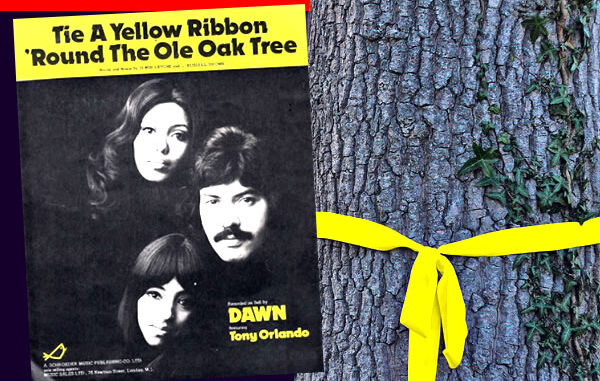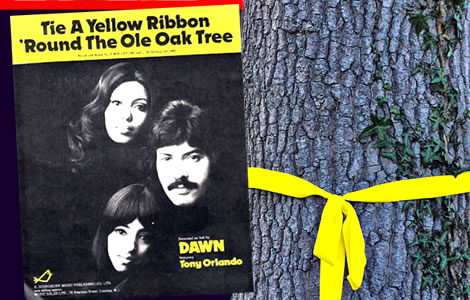
In the annals of pop music history, few songs have resonated as deeply and widely as “Tie a Yellow Ribbon Round the Ole Oak Tree” by Tony Orlando and Dawn. Released in 1973, this catchy tune not only dominated the charts but also ingrained itself into the cultural fabric of the era, symbolising hope, forgiveness, and reunion.

Its widespread appeal and enduring legacy make it a quintessential radio memory for many who lived through the early 1970s.
Chart-Topping Success
Upon its release in February 1973, “Tie a Yellow Ribbon Round the Ole Oak Tree” quickly captured the hearts of listeners.
In the United States, the song soared to the pinnacle of the Billboard Hot 100 chart, where it held the number one position for four consecutive weeks from April 21 to May 12, 1973.
Its popularity was not confined to the U.S.; the song achieved international acclaim, reaching number one in several countries.
In the United Kingdom, the song mirrored its American success. It clinched the top spot on the UK Singles Chart and maintained its dominance for four weeks in April and May of 1973.
The song’s universal themes and infectious melody contributed to its widespread appeal, allowing it to transcend cultural boundaries.
Worldwide, “Tie a Yellow Ribbon” topped charts in countries such as Australia, where it reigned supreme on the Kent Music Report, and in Canada, where it led the RPM 100 National Singles Chart.
Its pervasive presence on radio airwaves and jukeboxes solidified its status as one of the defining songs of the early 1970s.
The Story Behind the Song
The narrative of “Tie a Yellow Ribbon” is both poignant and relatable. It tells the story of a man returning home after a three-year incarceration, uncertain if his beloved still wants him.
He asks her to tie a yellow ribbon around the old oak tree if she welcomes him back. Upon arrival, he is overwhelmed to see a hundred yellow ribbons, signalling her enduring love and forgiveness.
This tale of redemption and hope resonated deeply with audiences, especially during a time when many American soldiers were returning from the Vietnam War, seeking acceptance and reintegration into society.
The yellow ribbon became a powerful symbol of support and remembrance, a testament to the song’s profound cultural impact.
Tony Orlando: Before and After the Ribbon
Before the monumental success of “Tie a Yellow Ribbon,” Tony Orlando had already carved a niche for himself in the music industry. Born Michael Anthony Orlando Cassavitis on April 3, 1944, in New York City, Orlando began his musical journey in the early 1960s.
He achieved modest success with hits like “Halfway to Paradise” and “Bless You,” which charted in the U.S. and the UK.
However, by the late 1960s, Orlando had transitioned behind the scenes, working as a music executive at CBS Records. It wasn’t until he was approached to record the song “Candida” under the pseudonym “Dawn” that his performing career reignited.
The song, released in 1970, became a surprise hit, prompting Orlando to assemble a group, later known as “Tony Orlando and Dawn,” featuring Telma Hopkins and Joyce Vincent Wilson.
Following the success of “Candida,” the group enjoyed a series of hits, including “Knock Three Times,” which topped charts in 1971. However, it was “Tie a Yellow Ribbon Round the Ole Oak Tree” that catapulted them to international stardom.
Post-“Yellow Ribbon,” Tony Orlando and Dawn continued to enjoy success with songs like “Say, Has Anybody Seen My Sweet Gypsy Rose” and “He Don’t Love You (Like I Love You).” They also ventured into television, hosting “The Tony Orlando and Dawn Show,” a variety series that aired from 1974 to 1976.
By the late 1970s, the group disbanded, and Orlando faced personal challenges, including issues with substance abuse and depression. However, he made a triumphant return to the entertainment scene in the 1980s, performing in various venues and making television appearances. His resilience and enduring talent have solidified his legacy in the music world.
A Glimpse into 1972: Setting the Stage
While “Tie a Yellow Ribbon” dominated the airwaves in 1973, the preceding year, 1972, set the cultural and historical backdrop against which the song would emerge.
In television, detective series were immensely popular, with shows like “Columbo,” starring Peter Falk as the disheveled yet sharp-witted detective, captivating audiences worldwide.
Another favorite was “Hawaii Five-O,” featuring Jack Lord as Steve McGarrett, leading a special state police task force. These series, along with others like “Ironside” and “McMillan & Wife,” were distributed globally, becoming staples of international television.
On the news front, 1972 was rife with significant events.
The Watergate scandal began unfolding in June when five men were arrested for breaking into the Democratic National Committee headquarters, leading to a political crisis that would eventually culminate in President Richard Nixon’s resignation.
The Munich Olympics in September were marred by tragedy when members of the Israeli Olympic team were taken hostage and killed by the terrorist group Black September.
Additionally, the year witnessed the signing of the SALT I treaty between the U.S. and the Soviet Union, marking a crucial step in nuclear arms control. The Vietnam War continued to dominate headlines, with intensified bombings and peace negotiations making sporadic progress.
Capitol.fm – recreating the Zeitgeist
“Tie a Yellow Ribbon Round the Ole Oak Tree” remains a testament to the power of music to capture the zeitgeist of an era. Through its heartfelt narrative and memorable melody, the song encapsulated themes of hope, redemption, and love, resonating with millions worldwide.
Tony Orlando’s journey, both before and after this hit, reflects the ebbs and flows of an artist’s life, marked by triumphs and challenges.
As we reminisce about this classic tune, we are transported back to a time of iconic detective shows and pivotal world events, painting a rich tapestry of the early 1970s.
